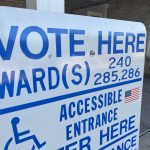The Truth About Busing
Is Harris or Biden right? The impact of busing in Milwaukee and other cities.

School Buses. Photo by Jan-Erik Finnberg. Image trimmed (CC BY 2.0).
I had to laugh when Joe Biden, in his exchange with Kamala Harris about his historic opposition to busing, said it wasn’t so, that he favored “voluntary” busing.
There wasn’t exactly a lot of voluntary busing going on in the 1970s, when Biden opposed “forced busing,” as he termed it. Young Kamala Harris was part of a rare voluntary plan in liberal Berkeley, California. Most busing was in response to federal court orders enforcing the U.S. Supreme Court’s 1954 Brown decision and its 1955 follow-up decision ordering the integration of America’s schools “with all deliberate speed.” And they were not popular.
In Louisville there were bomb scares, boycotts and Klan rallies. In Boston there was rock throwing, bricks and bloodshed. In Milwaukee a majority of the school board adamantly opposed desegregation, South-Side Congressman Clement Zablocki declared “It makes my blood boil” and Mayor Henry Maier said of the court order, “I would obey it, but I would resent it.”
But Milwaukee and countless other cities were desegregated, only to gradually become re-segregated in the decades since then, as the nation moved away from busing. So the dust-up between Biden and Harris, in addition to helping her rise in the polls while raising doubts about him, also tore the scab off an ugly wound on the national body politic: busing and integration of the schools is a painful topic relegated to the past that few politicians are eager to revive.
Busing was certainly a political failure. It was never popular with Americans. A Washington Post story notes that a 1972 national poll found only 20 percent of Americans favored “busing schoolchildren to achieve racial balance,” and a 1978 poll found only 25 percent agreed that “racial integration of the schools should be achieved even if it requires busing.” By 1999 a Gallup poll found 82 percent of respondents said letting students go to their neighborhood schools would be better than achieving racial balance through busing. But African Americans were considerably more supportive, with 44 percent supporting busing.
Mitchell quotes a 1999 poll of Milwaukeeans that found 56 percent of blacks opposing busing, a significantly higher percentage than nationally, but that might be because of the nature of the Milwaukee plan, which placed all the busing burden on black families.
In 1986, ten years after Milwaukee’s desegregation plan was launched, researcher John Pawasarat and I co-wrote an investigative feature for Milwaukee Magazine which analyzed the ingeniously complicated plan created by MPS deputy superintendent David Bennett, which was advertised as a choice plan that would use “magnet” or speciality schools to attract students to integrated schools. In fact only one of eight students attended such schools, which were devised as a way to sell white students on choosing schools outside their neighborhood.
Black students, by contrast, had a “forced choice,” as one student who confronted MPS Superintendent Lee McMurrin in a video about the new system put it. Bennett’s plan capped the enrollment and closed down many schools in black neighborhoods so children were forced to bus to other schools. But the system was so complicated, with each student’s parents filling out a form with their top three choices of schools and then getting assigned one (or sometimes none) of them, that it took years for parents to begin to understand it. As researcher Lois Quinn documented, there were 3,194 different exchanges of students just between elementary schools in the system.
But most of those transfers involved black students. During the first 10 years of integration, 85 percent of the students bused for desegregation were black. Students from the Auer school’s inner-city attendance area were scattered to 95 of the 108 MPS elementary schools.
The goal was to avoid the kind of blow-up that occurred in Boston and Milwaukee’s plan succeeded. “It’s almost like a miracle,” McMurrin declared. A 1978 study by the Council of Great City Schools cited Milwaukee for having the most successful desegregation effort of 30 cities studied.
But over time it became clear that the method used to achieve this was a cynical charade meant to dupe black families in Milwaukee and pacify a school board that opposed busing. The Brown decision sought educational equity or “simple justice”, as author Richard Kluger termed it, but Milwaukee’s plan was massively unequal in its busing burden while disrupting black neighborhoods in the city.
For activist Howard Fuller, who would later serve for several years as MPS superintendent, the Bennett plan was so fraudulent it helped turn him against any integration plan. He even floated a plan to carve out an all-black district within MPS.
Meanwhile, for many white families, the idea of busing outside their neighborhood, even to attend a speciality school of their choice, was unattractive. The result was massive white flight. Between 1975 (the year before desegregation) and 1985, our feature found, about one third of all non-black children in Milwaukee had moved to areas outside the city. The other kind of white flight during this period was to parochial (Catholic and Lutheran) schools: the percent of white elementary students in the city attending private schools doubled during this period.
In 1975 whites accounted for 56 percent of MPS enrollment. By 1985 that figure had plummeted to 32 percent. Meanwhile the percent of white residents in the city had dropped significantly.
Opponents of busing argued that white flight proved it was a political failure. And by the late 1990s the courts began moving away from requiring integration and most Americans began to see busing as an archaic concept, even as schools in America became resegregated.
But while it may have been a political failure, busing for desegregation was clearly an educational success. Noted author and researcher Richard Rothstein has summarized the many studies on this, which found that desegregated schools resulted in significant benefits for African Americans, including reduced dropout rates, less incarceration, fewer homicide arrests and less homicide victimization, and higher adult earnings and less poverty for adults who had attended integrated schools.
“Indeed, research has consistently shown that integrated schools offered, and still offer, tangible benefits to students of color,” as Chalkbeat’s review of the research found. And as desegregation orders were lifted in schools, researchers found the drop-rate for minority students rose, and the rate at which they enrolled in college declined. Finally, researchers found the achievement level of white students in desegregated schools did not decline.
But most city school systems are less integrated today than they were at the onset of busing. Today, just 11 percent of MPS students are white. And white flight to suburban and exurban areas has probably contributed to the partisan split that is at its extreme in metro areas like Milwaukee. But there is one issue a large majority of voters in America’s red and blue counties seem to agree on: they oppose busing for integration.
If you think stories like this are important, become a member of Urban Milwaukee and help support real independent journalism. Plus you get some cool added benefits, all detailed here.
Murphy's Law
-
Top Health Care Exec Paid $25.7 Million
 Dec 16th, 2025 by Bruce Murphy
Dec 16th, 2025 by Bruce Murphy
-
Milwaukee Mayor’s Power in Decline?
 Dec 10th, 2025 by Bruce Murphy
Dec 10th, 2025 by Bruce Murphy
-
Total Cost of Foxconn Is Rising
 Dec 8th, 2025 by Bruce Murphy
Dec 8th, 2025 by Bruce Murphy






















I was in the teacher training program at Marquette University when the federal courts ordered MPS to integrate. I remember there was a community-based group that included parents and teachers from across the city. This group developed an innovative integration plan that proposed a system in which the burden of integration was shared relatively equally. That plan had broad community support in part because it called for significant investment in inner city neighborhood schools that had been underfunded for decades. MPS ignored the work of this group and instead implemented the Bennett Plan, which was enormously complex, relied on an enormous amount of busing, which placed the lion share of the burden on communities of color. Instead of investing in underfunded neighborhood schools, MPS closed them. I think it is fair to say that the Bennett Plan was not successful.
The plan devised by this community-based group was very similar to the plan implemented in Minneapolis and St. Paul schools, which was quite successful.
As Joel McNally notes in this week’s Shepherd, one reason integrated schools aided African-American students is that most white parents were entirely used to complaining to school authorities when things went wrong…and to being listened to. And, indeed, were more likely TO be listened to than African-American parents who complained.